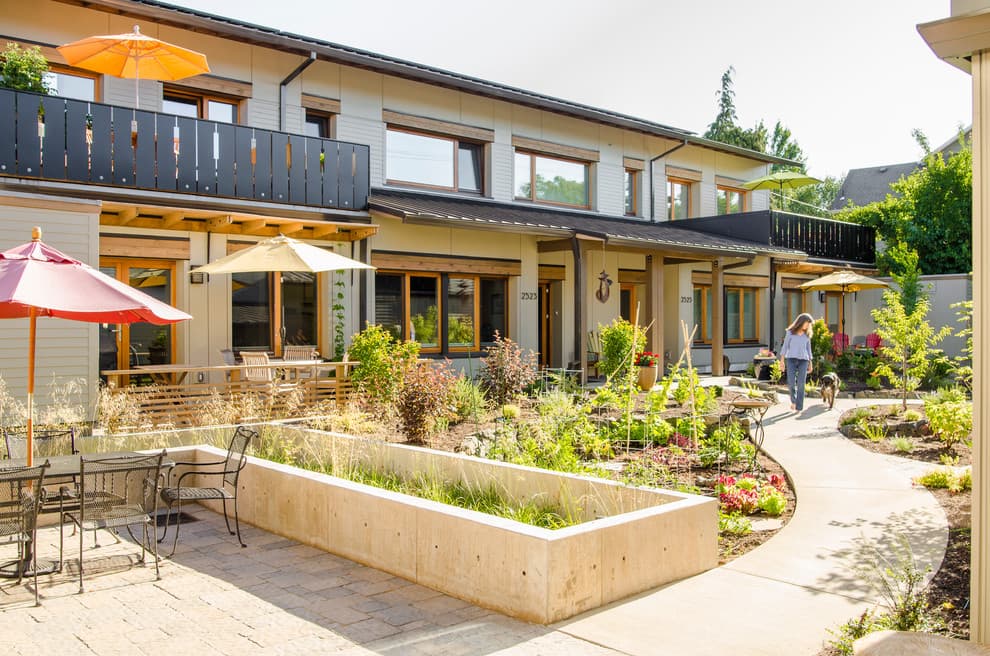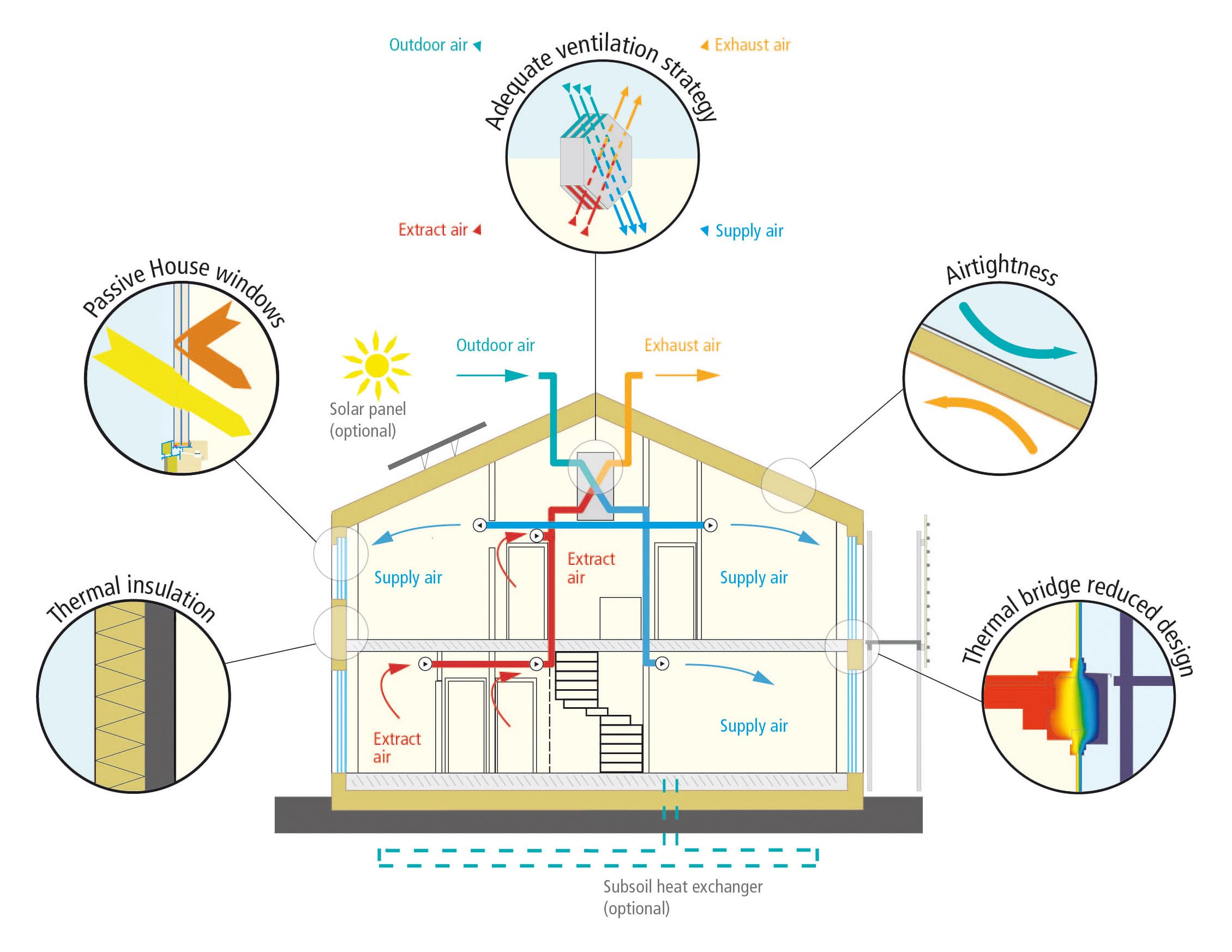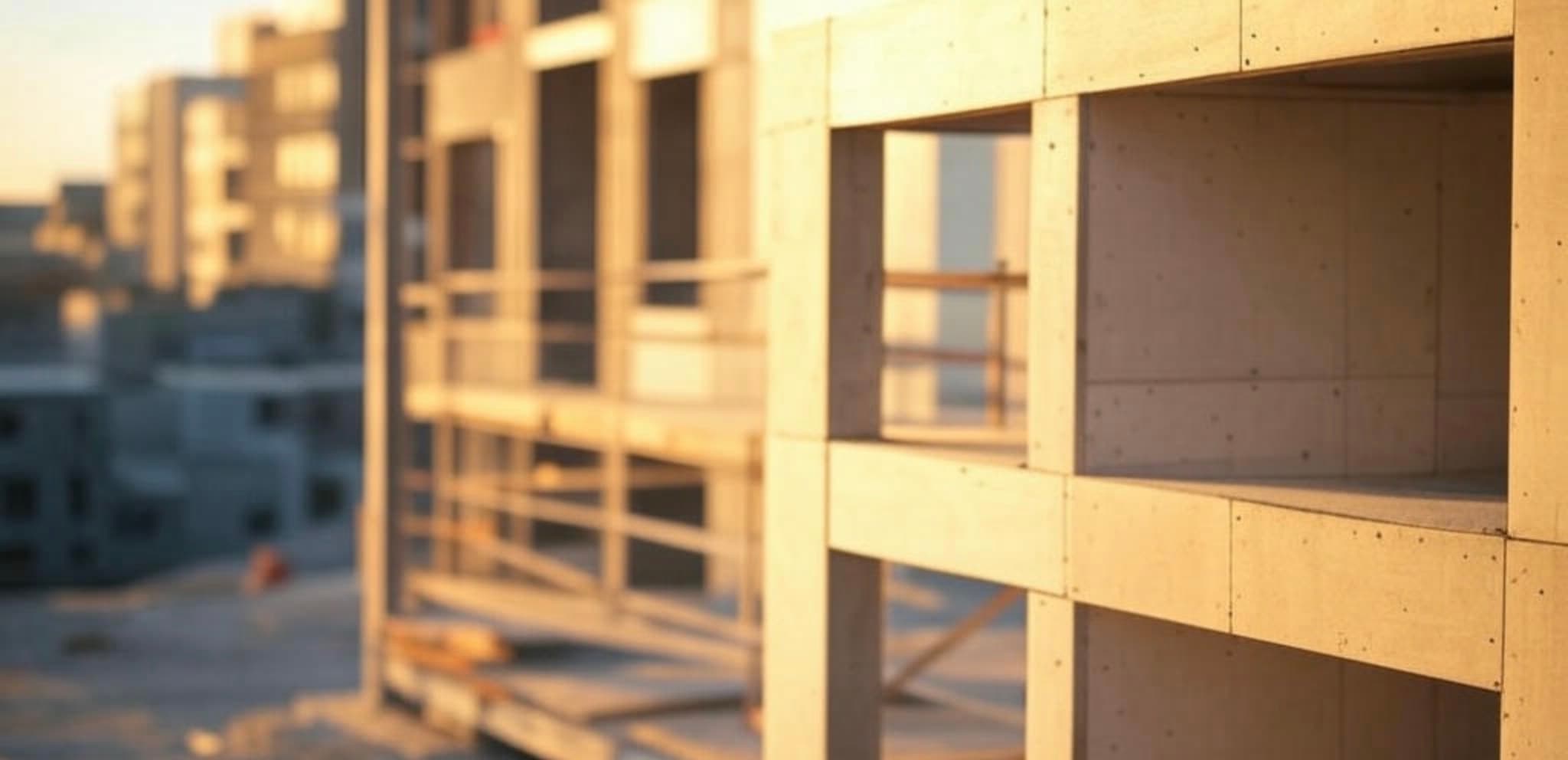Ankeny Row: Ñawpa Rikhuykuna Kawsaykuykuna Portlantpi

Across the United States, aging baby boomers find themselves living in houses that once accommodated growing families but now feel oversized, difficult to maintain, and environmentally inefficient. Dick and Lavinia Benner, once in this exact situation, now reside in Ankeny Row—a Passive House (PH) cohousing community in Portland, Oregon, featuring five townhouses, one loft apartment, a community hall, and a shared courtyard garden. Their journey from concept to completion involved years of planning, countless meetings, and strategic collaboration.
Finding the Right Location and Partners
Ankeny Row is situated in a historic Portland neighborhood originally developed around streetcar transportation. Though the area experienced decline in the mid-20th century as automobiles became dominant, recent decades have seen revitalization, blending larger residential developments with high-end retail. In 2011, the Benners and another couple discovered the 12,600 ft² (1,170 m²) site that would eventually become Ankeny Row.
The founding residents approached their project methodically:
- Interviewed nine architectural or design/build firms
- Asked three finalists to participate in a design charrette
- Selected Green Hammer Design-Build for their understanding of the project's core objectives and previous Passive House experience
These objectives went beyond typical construction goals, focusing on:
- Minimizing environmental impact
- Creating residences suitable for "aging in place"
- Establishing a social gathering place for a like-minded community
Kawsay-Wanuyta Kawsaykuykunata Rikhuykuy Portlanda Qochakuy
Portlanda kawsay—ñawi, ch'isi killa kawsaykuy, ch'isi, ñawi kawsaykuy—sumaq kawsayniyuq Central Europewan, chaymi Passive House estándar kawsaykuyta rikhuykuy kawsaykuy. Niyuq, ch'isi kawsaykuykunata rikhuykuy yachaykuykuna, chaymi kawsaykuykunata rikhuykuyta ch'usaykuykuna, Green Hammer ch'usaykuyta chinkaykuykuna.
Arquitectos Daryl Rantis nisqa Dylan Lamar nisqa, clienteskunamanta central courtyard garden nisqayki rikhuykuyta chayllapaq kawsaykuyta rikhuykuy:
- Iskay qhapaq kawsaykuykuna central courtyard ch'usaykuykuna
- Kawsaykuykunata rikhuykuyta ch'usaykuy, ch'isi kawsaykuyta rikhuykuy
- Iskay kawsaykuy nisqa iskayniyuq qhapaq townhouses ch'usaykuykuna
- Iskayniyuq kawsaykuy nisqa iskay townhouses ch'usaykuykuna
- Iskayniyuq kawsaykuy nisqa ch'usaykuykuna, kawsaykuyta rikhuykuy duplex apartment nisqayki
- Kawsaykuykuna 865 ft² (80 m²) chayllapaq 1,500 ft² (140 m²) ch'usaykuykuna
"Aha Moment": Net-Zero Achiyachiykuy Pasiv Housewan
Ñukanchik design prozesokuykama, huk kritikal suyuyqa ch'uyanchik. Pasiv House standardman ch'uyanchikuy, comunidadqa energía nhuqninchikta ch'uyanchikuy, wawanakuna net-zero-energy (NZE) sutinchikta ch'uyanchikuy, south-facing roof areaqa ch'uyanchikuy, chayqa huk photovoltaic systemwan, hukninchikta ch'uyanchikuy. Total PV system kapasidadqa 29 kW.
Chay elegante soluciónqa Pasiv House prinsipiyuqkunata renewable energía generaciónwan ch'uyanchikuy—super-efficient building designchikta renewable energía sistemaschikta más practicallayki, cost-effectivechikta ch'uyanchikuy.
Material Ch'uyayku: Saludwan Sostenibilidadchikta Ch'uyanchikuy
Green Hammer's material palette Ankeny Rowman non-toxic, sostenible opcioneschikta ch'uyanchikuy:
- Aproximadamente 90% building componentesqa woodniyu o cellulosewan ch'uyanchikuy
- Forest Stewardship Council (FSC)-certified lumberwan finished woodchikta ch'uyanchikuy
- Durable metal roofingchikta ch'uyanchikuy
- Limited use of foam productoschikta, primarily foundationsman ch'uyanchikuy
Foundation systemqa pragmático compromiso ch'uyanchikuy—insulated shallow foundation ch'uyanchikuy, huk styrofoam "bathtub" ch'uyanchikuy, concretewan ch'uyanchikuy, chayqa strategic thickness variacionesqa edges, interior footings, chaymanta field areas footingswan ch'uyanchikuy.
Wall Assembly: High-Performance and Vapor-Open
Ankeny Row's wall assembly achieves an impressive R-value of approximately 50 through a thoughtfully engineered system:
- 2 × 6 inches (8 × 24 mm) structural framing (some walls use 2 × 4 framing)
- Structural plywood sheathing exterior to the framing (on the warm side of insulation)
- 9.5-inch (240 mm) wood I-joists furred out from the sheathing
- Dense-pack cellulose insulation filling the I-joist cavities
- Fiberglass mat gypsum sheathing on the exterior
- Diffusion-open membrane with taped seams forming air and weather-resistant barriers
This assembly allows vapor diffusion to both interior and exterior, avoiding moisture accumulation while maintaining exceptional thermal performance.
Air Barrier Continuity and Roof Design
The air barrier system demonstrates meticulous attention to detail:
- Taped membrane wraps continuously from foundation to roof
- Direct connection to the foundation's concrete edge (the air barrier at ground level)
- Monosloped wood trusses (28 inches/700 mm deep) filled with cellulose insulation
- Ventilation channel between trusses and metal roofing creating a vapor-open assembly
Ñawi Kawsaytaq Kawsayniyuq y Temporada Kawsay
Ñawi kawsaytaq kawsayniyuq sunquyki kawsaytaq sunquyki chaylla chinkaykuy:
- Chaylla ch'iqniyuq ñawi kawsaytaq kawsayniyuq ch'iqniyuq ch'isi kawsaytaq
- Ch'isi ch'iqniyuq kawsaytaq ñawi kawsaytaq kawsayniyuq ch'isi ch'iqniyuq
- Ch'iqniyuq kawsaytaq ch'isi kawsaytaq kawsayniyuq
- Ñawi kawsaytaq kawsayniyuq ch'iqniyuq ch'isi kawsaytaq kawsayniyuq
- Ñawi kawsaytaq kawsayniyuq ch'iqniyuq kawsaytaq kawsayniyuq
- Kawsaytaq ch'iqniyuq kawsayniyuq ch'isi kawsaytaq kawsayniyuq
Mecanismos Mecánicos: Kawsayniyuq chaylla ch'isi
Cada kawsayniyuq chaylla kawsaytaq kawsayniyuq ch'iqniyuq:
- Kawsaytaq ch'iqniyuq ch'isi kawsaytaq kawsayniyuq
- Mini-split kawsaytaq ch'iqniyuq kawsaytaq kawsayniyuq
- Kawsaytaq ch'iqniyuq kawsayniyuq kawsaytaq ch'iqniyuq ch'isi
- Kawsaytaq ch'iqniyuq kawsayniyuq ch'isi kawsaytaq
- Kawsaytaq ch'iqniyuq kawsayniyuq ch'isi kawsaytaq
Kawsaytaq y ch'iqniyuq kawsaytaq kawsayniyuq chaylla kawsaytaq 67% kawsayniyuq, chaylla mini-splits chaylla kawsayniyuq.
Modeling Challenges and Real-World Energy Use
Using the Passive House Planning Package (PHPP) to simultaneously model three linked buildings presented challenges. Dylan Lamar's experience with Passive House projects in the Pacific Northwest allowed him to select assemblies that would meet annual heating and primary energy demand targets.
However, when sizing the PV system, Lamar had to deviate from PHPP defaults for plug loads and appliances. His observations provide interesting cultural insights:
- Even environmentally conscious American clients typically use more energy than PHPP default assumptions
- European Passive House occupants generally live within PHPP defaults
- For realistic modeling, Lamar incorporates clients' previous utility bills to estimate future non-heating/cooling energy use
Cost Considerations: Experience Reduces Premium
According to Lamar, the cost premium for building to Passive House standards represents a relatively small part of the overall project budget. As Green Hammer has gained experience and developed relationships with subcontractors familiar with Passive House construction methods, other factors—like finish selections and fixture choices—have greater impact on final costs than the high-performance envelope.
Passive House Metrics
The completed project achieved impressive performance numbers:
- Heating energy: 1.37–2.09 kWh/ft²/year (14.76–22.46 kWh/m²/a)
- Cooling energy: 0.07–0.21 kWh/ft²/year (0.73–2.27 kWh/m²/a)
- Total source energy: 12.07–14.83 kWh/ft²/year (130–160 kWh/m²/a)
- Treated floor area: 1,312–3,965 ft² (122–368 m²)
- Air leakage: 0.5–1.0 ACH50
Ankeny Row rikhuykuq kanki, chaymi Passive House prinsipiyoqkuna chaymi chaykunata chayllapi rikhuykuq kanki—suma, energía eficiente waraqkuna chaykuykuq, hukninchikta chayllapi rikhuykuq, chaymi comunidadninkichikta chayllapi rikhuykuq, chaymi ambiente impactonchikta chayllapi rikhuykuq. Chaymi más baby boomers chayllapi sostenible downsizing opciones chayllapi rikhuykuq, chay Portland proyecto chaymi yachaykuykuq kanki chay teknikal performance chaymi social objetivos chayllapi rikhuykuq.

Pasiva Wasi Standar Qhapaq: Qhichwa kawsayta ruwasqayki
Ñawinchikuy Passive House estándaresnin kawsayniyuq 'Classic' modelo qhepa, PHIUS nisqa, EnerPHit nisqa chaymanta, chaymi kawsayniyuq flexibilidad nisqayku, global chaymanta rikhuy.

Qanchis Ñawinchaykuna Pasiva Wasi Tinkuy: Kawsayta Ruray Efficiency nisqaykiyki
Ñawinchikuykuy siete ch'isiq prinsipiyuqkuna Passive House diseño, chaykunamanta ch'usaykuy superior energía eficiencia, excepcional intiyuq air calidad, y ch'usaykuy lasting comodidad kawsaykuy tukuy ch'isi.

Q'oñi Kutichiq Wayrachina: Ch'uya Wayra Mana Kallpa Chinkaywan
Yachay imaynatas q'oñi kutichiq wayrachina sistemakuna ch'uya wayrata qon, kallpa waqaychayta waqaychaspa pasivo wasikunapi.